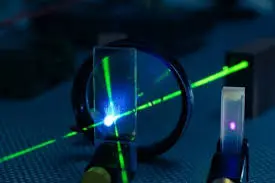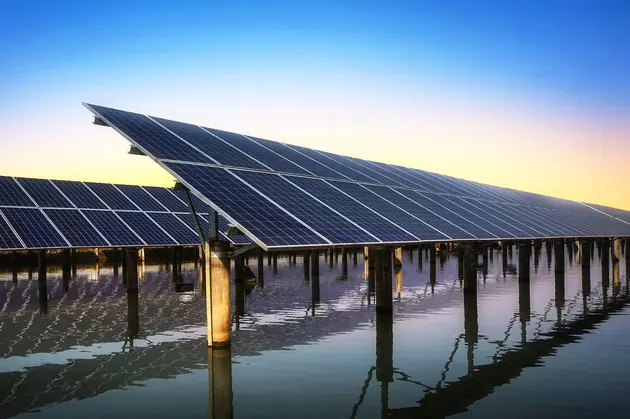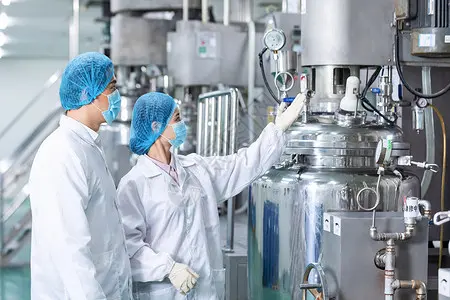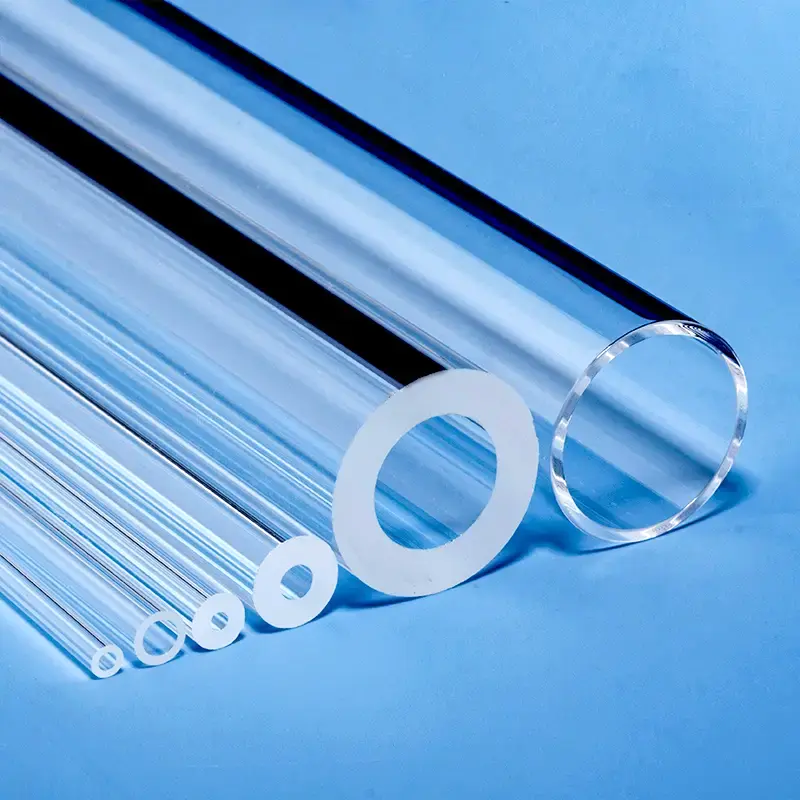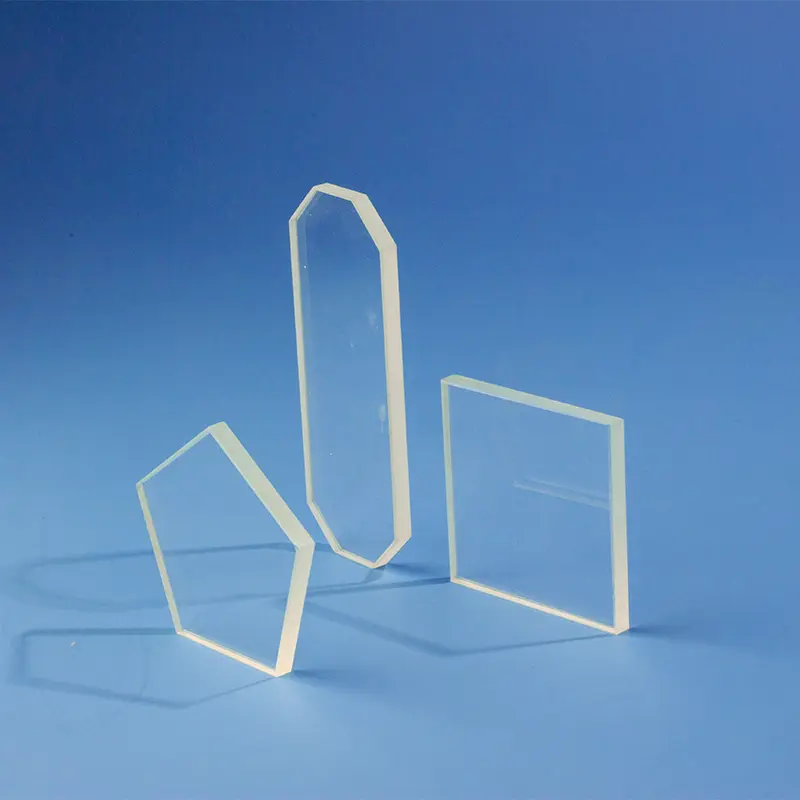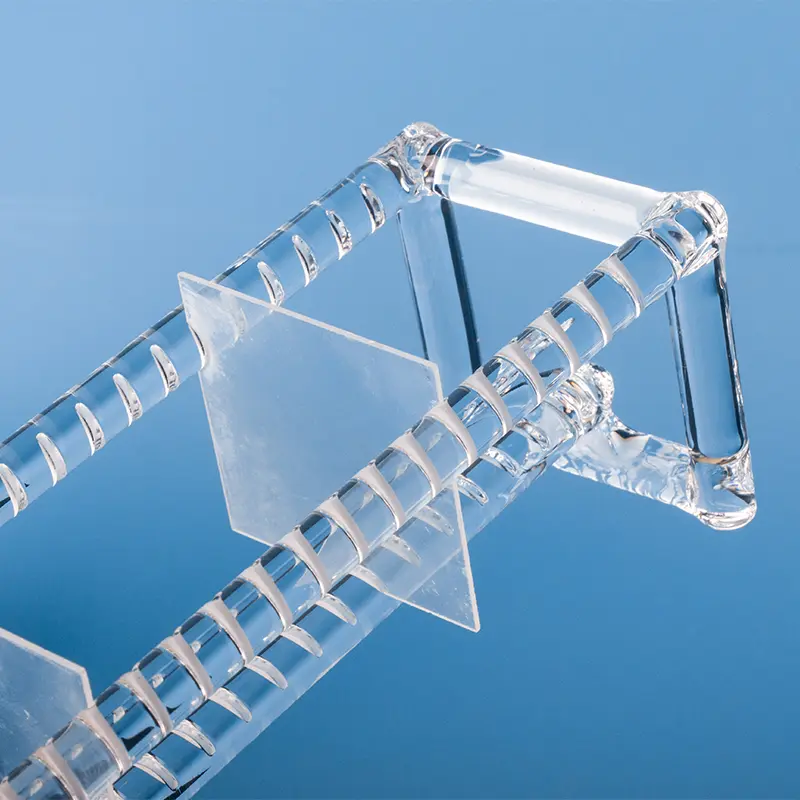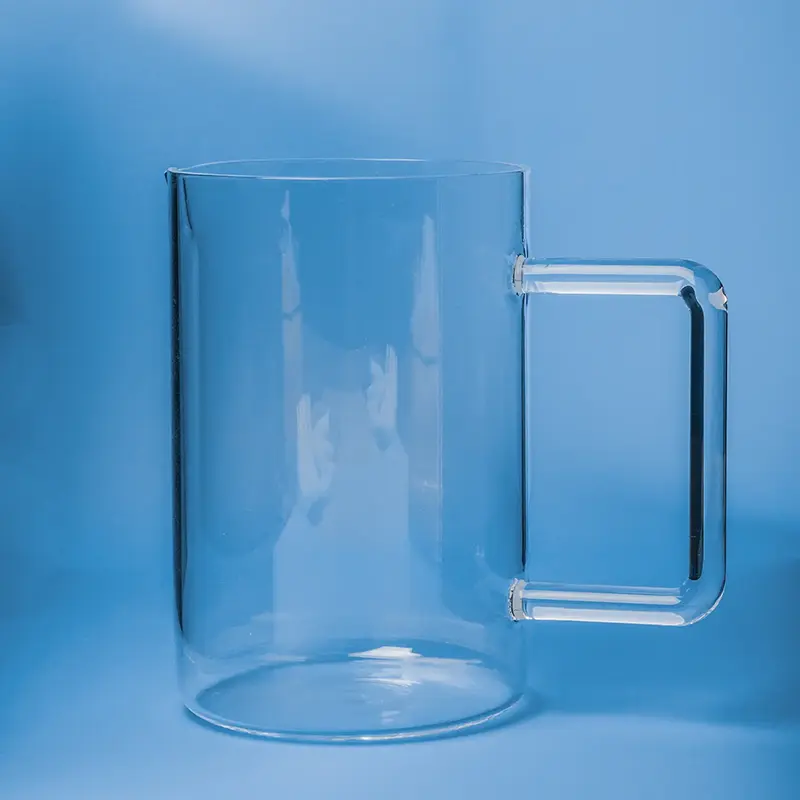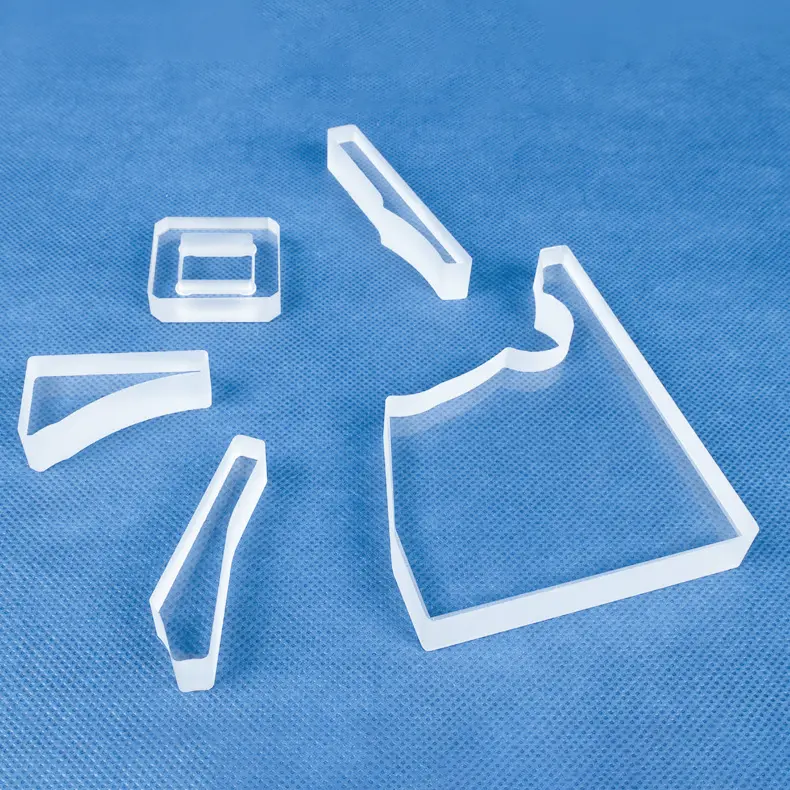Quartz glass sheets are a specialized type of glass characterized by high transparency, high-temperature resistance, and strong chemical stability. They are widely used in fields such as optical fiber communication, semiconductor manufacturing, and medical equipment. Renowned for their exceptional optical properties, low thermal expansion coefficient, and excellent electrical insulation, quartz glass sheets are an indispensable material in various high-tech applications.
| Length | Width | Thickness |
|---|---|---|
| 5mm | 5mm | 1mm |
| 10mm | 10mm | 0.5mm |
| 10mm | 10mm | 1mm |
| 10mm | 10mm | 2mm |
| 12mm | 12mm | 1mm |
| 15mm | 15mm | 0.5mm |
| 15mm | 15mm | 1mm |
| 15mm | 15mm | 2mm |
| 15mm | 15mm | 3mm |
| 20mm | 20mm | 0.5mm |
| 20mm | 20mm | 1mm |
| 20mm | 20mm | 2mm |
| 20mm | 20mm | 3mm |
| 25mm | 25mm | 0.5mm |
| 25mm | 25mm | 1mm |
| 25mm | 25mm | 2mm |
| 25mm | 25mm | 3mm |
| 30mm | 30mm | 0.5mm |
| 30mm | 30mm | 1mm |
| 30mm | 30mm | 2mm |
| 30mm | 30mm | 3mm |
| 35mm | 35mm | 1mm |
| 35mm | 35mm | 2mm |
| 35mm | 35mm | 3mm |
| 40mm | 40mm | 0.5mm |
| 40mm | 40mm | 1mm |
| 40mm | 40mm | 2mm |
| 40mm | 40mm | 3mm |
| 45mm | 45mm | 1mm |
| 45mm | 12mm | 1mm |
| 45mm | 12mm | 2mm |
| 35mm | 35mm | 2mm |
| 50mm | 50mm | 0.5mm |
| 50mm | 50mm | 1mm |
| 50mm | 50mm | 2mm |
| 50mm | 50mm | 3mm |
| 50mm | 50mm | 4mm |
| 50mm | 50mm | 5mm |
| 60mm | 60mm | 1mm |
| 60mm | 60mm | 2mm |
| 60mm | 60mm | 3mm |
| 70mm | 70mm | 2mm |
| 70mm | 70mm | 3mm |
| 70mm | 70mm | 5mm |
| 75mm | 25mm | 0.5mm |
| 75mm | 25mm | 1mm |
| 75mm | 25mm | 2mm |
| 80mm | 80mm | 1mm |
| 80mm | 80mm | 2mm |
| 80mm | 80mm | 3mm |
| 80mm | 80mm | 4mm |
| 100mm | 100mm | 1mm |
| 100mm | 100mm | 1.5mm |
| 100mm | 100mm | 2mm |
| 100mm | 100mm | 3mm |
| 100mm | 100mm | 5mm |
| 100mm | 100mm | 0.5mm |
| 100mm | 100mm | 1mm |
| 100mm | 100mm | 2mm |
| 100mm | 100mm | 3mm |
| 100mm | 100mm | 5mm |
| 150mm | 150mm | 2mm |
| 150mm | 150mm | 3mm |
| 150mm | 150mm | 5mm |

- ayment method: By wire transfer or advance payment, depending on the quantity of the order.
- Delivery time: According to the order quantity.
- Transportation method: Sea freight or air freight, depending on the customer.
Remarks:
To confirm the order, The following parameters need to be provided: ① Square: length, width, thickness ② Circle: diameter, thickness ③ Accuracy ④ Quantity
| Contenido de la propiedad | Valores inmobiliarios |
|---|---|
| SiO2 | 99.99% |
| Densidad | 2,2×10³ kg/cm³ |
| Dureza | 5,5 - 6,5 Escala de Mohs 570 KHN 100 |
| Resistencia a la tracción | 4,8×10⁷ Pa (N/mm2) (7000 psi) |
| Resistencia a la compresión | >1,1×10⁹ Pa (160.000 psi) |
| Coeficiente de dilatación térmica | 5,5×10-⁷ cm/cm-°C (20°C-320°C) |
| Conductividad térmica | 1,4 W/m-°C |
| Calor específico | 670 J/kg-°C |
| Punto de ablandamiento | 1730°C (3146°F) |
| Punto de recocido | 1210°C (2210°F) |
| Punto de deformación | 1120°C (2048°F) |
| Temperatura de trabajo | 1200°C (2192°F) |
| Resistividad eléctrica | 7×10⁷ ohm cm (350°C) |
| Talla | Personalizado |
| Logotipo | Logotipo personalizado Aceptar |
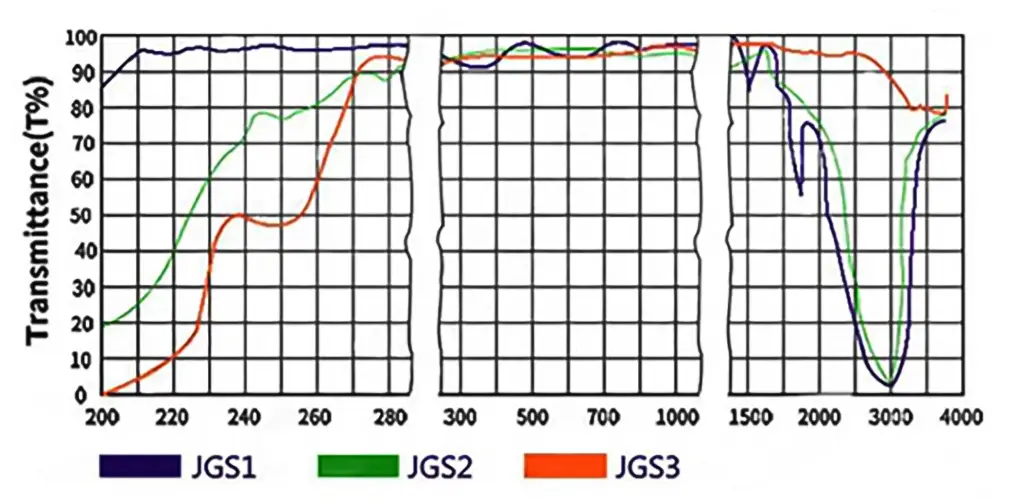
JGS1
Commonly known as UV-grade fused silica, this material exhibits exceptionally low dispersion and very high transmittance in the ultraviolet (UV) spectral range.
JGS2
Similar to JGS1, but may have variations in specific performance parameters such as transmittance and thermal expansion coefficient, depending on the manufacturer’s standards.
JGS3
Typically used in applications requiring higher purity or specialized performance characteristics. Specific performance parameters can vary based on the manufacturer.
Dispersion Characteristics
JGS1 and JGS2 quartz sheets exhibit excellent dispersion properties in the ultraviolet (UV) spectral range, effectively separating UV light of different wavelengths. This makes them ideal for manufacturing high-performance optical components.
Transmittance
All three types of quartz sheets have high transmittance to UV light, especially within specific wavelength ranges. For example, JGS1 has very high transmittance from 185 nm to 2,500 nm. This makes them the preferred materials for manufacturing UV lasers, UV spectrometers, and optical filters.
Chemical Stability
Quartz sheets possess excellent chemical stability and can withstand harsh conditions, including acids, alkalis, and high temperatures. Therefore, they are suitable for manufacturing chemical reactors, high-temperature furnace windows, and chemical analysis instruments.
Low Thermal Expansion Coefficient
These quartz sheets have very low thermal expansion coefficients, exhibiting minimal response to temperature changes. This is crucial for the stability of high-precision optical components.
Escenario de aplicación
Quartz sheets exhibit excellent high-temperature resistance, corrosion resistance, thermal stability, and light transmittance. Its softening point is approximately 1730°C, and it can be used continuously at 1100°C, with short-term usage up to 1450°C. Quartz glass is highly resistant to acids, with the exception of hydrofluoric acid, and demonstrates high resistance to chemical reactions with most other acids. Quartz sheets have a very low thermal expansion coefficient, enabling them to withstand rapid temperature changes without fracturing. They also exhibit good light transmittance across the entire UV to IR spectrum, with a visible light transmittance exceeding 93%.
Based on optical properties, quartz sheets are classified into three categories: far-ultraviolet (FUV) optical quartz glass (JGS1), ultraviolet (UV) optical quartz glass (JGS2), and infrared (IR) optical quartz glass (JGS3). These different types of quartz glass exhibit variations in transparency, absorption band positions, etc., in the UV and visible spectral ranges.
The processing of quartz sheets includes rough processing steps such as raw material sorting, rod bonding, seed crystal cutting, and rounding. This is followed by grinding stages, such as rough grinding, medium grinding, and fine grinding. Afterwards, polishing and cleaning processes are conducted to ensure surface quality and stability of the wafers. Finally, mounting and die-bonding involves fixing the quartz sheets with applied electrodes and applying conductive adhesive to the contact points between the electrodes and metal pads to achieve electrical connection.
Preguntas más frecuentes
El vidrio de cuarzo es un material duro y quebradizo con excelentes propiedades físicas y químicas, dureza mecánica extremadamente alta, buen aislamiento eléctrico, resistencia a altas temperaturas y a la corrosión, rendimiento de retardo bajo y estable, buena transmitancia luminosa, etc. Se utiliza ampliamente en semiconductores, óptica, electricidad, química, aeroespacial, automoción y otros campos. Los materiales duros y quebradizos son difíciles de procesar, y muchos campos necesitan urgentemente procesos de corte con un pequeño colapso del borde, menos pérdida de material, baja rugosidad de la sección transversal y un amplio rango de grosor de corte. El método de corte tradicional del vidrio de cuarzo es el corte mecánico, es decir, el corte por disco. Los métodos de corte no tradicionales incluyen el corte por chorro de agua, el corte por hilo de descarga electroquímica, el corte por láser continuo, etc. El corte mecánico tiene un bajo coste, pero el contacto entre la rueda y el material causa un gran desgaste de la herramienta, y el material es fácilmente contaminado por la herramienta. El vidrio de cuarzo es propenso al colapso de los bordes, las microfisuras y la tensión residual, lo que afecta a la resistencia y el rendimiento del material. Es difícil conseguir un corte curvo y requiere un tratamiento posterior, como esmerilado y pulido. El corte por láser no entra en contacto directo con el material, no tiene tensión de contacto y puede realizar cortes curvos complejos. El láser de picosegundos tiene las ventajas de un diámetro de punto pequeño, alta precisión, tiempo de acción corto con el material y área de acción pequeña, y es adecuado para el procesamiento de materiales duros y quebradizos.
。


